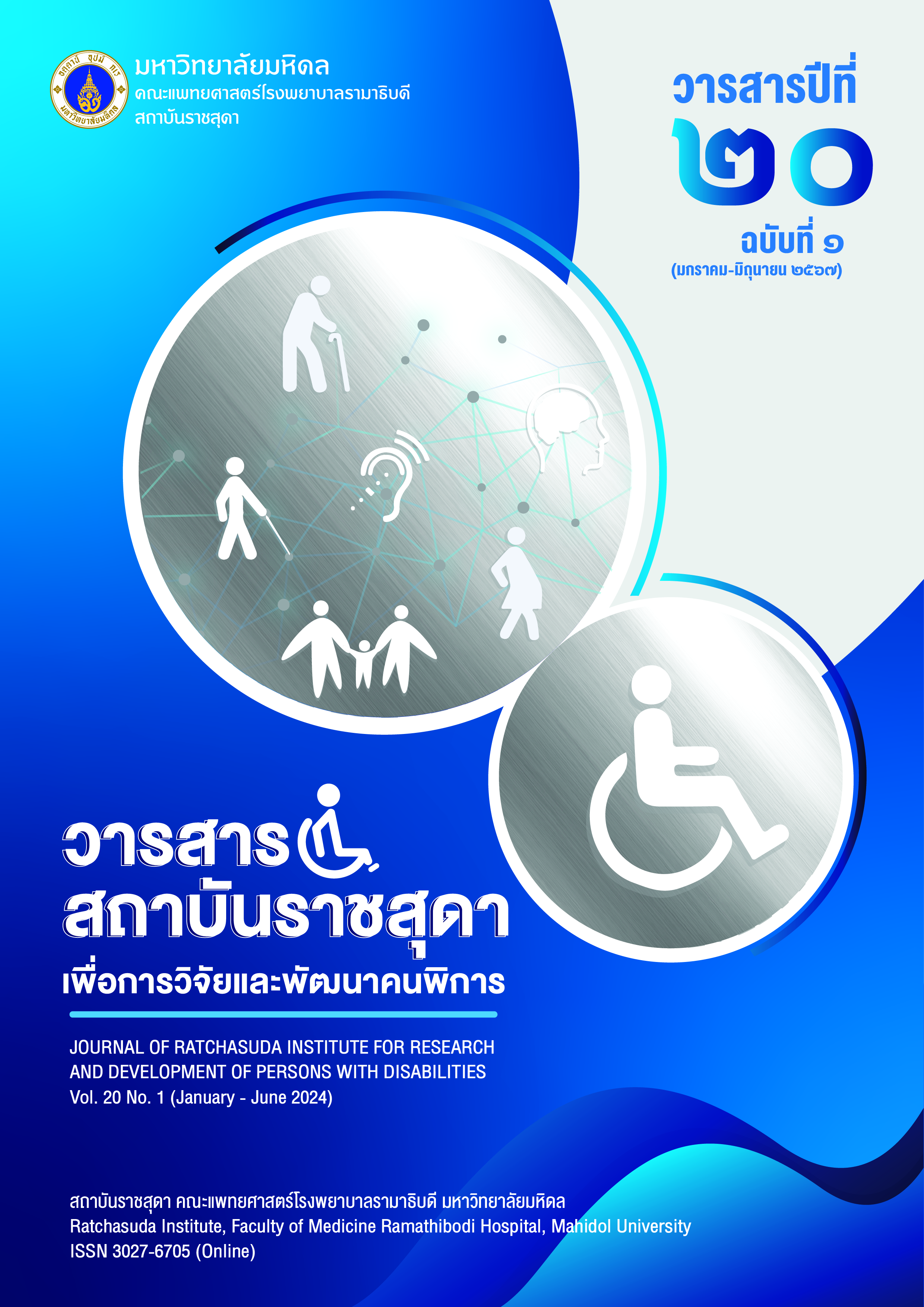The Result of Enhancing Self-Preservation Skills Activities from Peer Bullying in Secondary School Students with Special Needs
Keywords:
Peer Bullying , Students with Special NeedsAbstract
This research aimed to study the situation of peer bullying and the result of enhancing self-preservation skills activities for students with special needs at the secondary school level. The sampling group of the study was 32 students with special needs who were at the secondary school level. The research was divided into two phases. The first phase was to survey the incidence of peer bullying in school by using Olweus Bullying Questionnaires. The second phase of the research was to apply the designed activities to the students: Positive Self-talk and Circle of Trust activities. Single-stage cluster sampling is used to collect the data in both phases. The survey found that about 56.2% of students with special needs experienced peer bullying in school. Moreover, the most frequent types of bully are being excluded from the group and ignored by their classmates about 28.1% each. Furthermore, the place of bullying that happened most frequently is in the classroom when the teacher was not present, and in the hallway at 18.8% each. Interestingly, the study found that students with special needs also take the act of bullying others. The most frequent type of bullying was calling others bad names at 31.3% and mimicking others at 18.8%. In the second phase, after the students had participated in the activities. It showed that they had a better understanding of how to deal with the bullying situation by thinking and talking positively and learned to ask for help from the people in their trusted circle.
Downloads
References
Azwar, B., Wanto, D., & Hidayat, R. (2021). Improving self-resilience in students with special needs through the counseling teachers’ roles: A case study on grounded theory. Education Research International, 2021, 1–6. https://doi.org/10.1155/2021/7872889
Blake, J. J., Lund, E. M., Zhou, Q., Kwok, O.-m., & Benz, M. R. (2012). National prevalence rates of bully victimization among students with disabilities in the United States. School Psychology Quarterly, 27(4), 210–222. https://doi.org/10.1037/spq0000008
Corey, G. (2015). Theory and practice of group counseling (10th ed.). Cengage Learning.
González Contreras, A. I., Pérez-Jorge, D., Rodríguez-Jiménez, M. C., & Bernadette-Lupson, K. (2020). Peer bullying in students aged 11 to 13 with and without special educational needs in Extremadura (Spain). International Journal of Primary Elementary and Early Years Education 3-13, 49(8), 945-956. https://doi.org/10.1080/03004279.2020.1817965
Maguire, R., Wilson, A., & Jahoda, A. (2019). Talking about learning disability: promoting positive perceptions of people with intellectual disabilities in Scottish schools. International Journal of Developmental Disabilities, 65(4), 257–264. https://doi.org/10.1080/20473869.2018.1446497
Menesini, E., & Salmivali, C. (2017). Bullying in schools: the state of knowledge and effective interventions. Psychology, Health & Medicine, 22, 240–253. https://doi.org/10.1080/13548506.2017.1279740
Olweus, D. (1996). Bullying at School: Knowledge base and an effective intervention program. Annals of the New York Academy of Sciences, 794(1), 265-276.
Pan American Health Organization. (2021). Children with disabilities more likely to experience violence. https://www3.paho.org/hq/index.php? option=com_content&view=article&id=6998:2012-children-disabilities-more-likely-experience-violence&Itemid=135&lang=en
Sangarun, S. (2011). A study and development of self-prevention strategies for adolescent students from bullying through group counseling [Doctoral dissertation, Srinakarinwirot University]. Srinakarinwirot University. http://thesis.swu.ac.th/swudis/Coun_Psy/Samorn_S.pdf.
Sohrabi, R., Mohammadi, A., & Adalatzadeh, G. (2013). Effectiveness of Group Counseling with Problem Solving Approach on Educational Self-efficacy Improving. Procedia - Social and Behavioral Sciences, 84, 1782-1784. doi:10.1016/j.sbspro.2013.07.033
Tapunya, S. (2006). Report of peer bullying in school. Faculty of Medicine, Chiang Mai University.
UNESCO. (2021). Violence and bullying in educational settings: The experience of children and young people with disabilities. United Nations Educational, Scientific and Cultural Organization, France. https://unesdoc.unesco.org/ark:/48223/pf0000378061
Zweers, I., Scholte, R., & Didden, R. (2017). Bullying among youth with autism spectrum disorders. In Leaf, J. B. (Eds.), Handbook of Social Skills and Autism Spectrum Disorder (pp. 45–61). Springer. https://doi.org/10.1007/978-3-319-62995-7_4

Downloads
Published
How to Cite
Issue
Section
License
Copyright (c) 2024 Journal Of Ratchasuda Institute for Research and Development of Persons With Disabilities

This work is licensed under a Creative Commons Attribution-NonCommercial-NoDerivatives 4.0 International License.
บทความที่ได้รับการตีพิมพ์เป็นลิขสิทธิ์ของวารสารสถาบันราชสุดาเพื่อการวิจัยและพัฒนาคนพิการ





